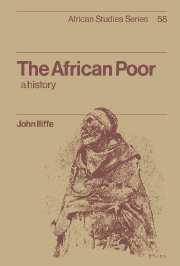Book contents
- Frontmatter
- Contents
- Preface
- 1 The comparative history of the poor
- 2 Christian Ethiopia
- 3 The Islamic tradition
- 4 Poverty and power
- 5 Poverty and pastoralism
- 6 Yoruba and Igbo
- 7 Early European initiatives
- 8 Poverty in South Africa, 1886–1948
- 9 Rural poverty in colonial Africa
- 10 Urban poverty in tropical Africa
- 11 The care of the poor in colonial Africa
- 12 Leprosy
- 13 The growth of poverty in independent Africa
- 14 The transformation of poverty in southern Africa
- Notes
- Bibliography
- Index
2 - Christian Ethiopia
Published online by Cambridge University Press: 31 October 2009
- Frontmatter
- Contents
- Preface
- 1 The comparative history of the poor
- 2 Christian Ethiopia
- 3 The Islamic tradition
- 4 Poverty and power
- 5 Poverty and pastoralism
- 6 Yoruba and Igbo
- 7 Early European initiatives
- 8 Poverty in South Africa, 1886–1948
- 9 Rural poverty in colonial Africa
- 10 Urban poverty in tropical Africa
- 11 The care of the poor in colonial Africa
- 12 Leprosy
- 13 The growth of poverty in independent Africa
- 14 The transformation of poverty in southern Africa
- Notes
- Bibliography
- Index
Summary
Ethiopia to the end of the nineteenth century is the logical place to begin a history of the African poor. Its hagiographies of saints and chronicles of kings are early written sources of a quality unique in Africa. Its Christian inheritance facilitates comparison with both medieval Europe and the rest of Africa, illuminating the distinctively African and the distinctively Christian elements in Ethiopia's pattern of poverty. Such comparison reveals that the Ethiopian poor were not unique products of a social order unique in Africa – plough-using, stratified, Christian, literate – but were chiefly the poor to be found in any pre-industrial society rich in land. In the long term it should be possible to write a true history of the Ethiopian poor, showing how their identity and experience changed between the thirteenth and the nineteenth centuries, but this will need a knowledge of Ethiopian languages not available here. Instead, this chapter indicates the broad character of the poor and their means of survival over some 700 years as a basis for comparison and change in sub-Saharan Africa as a whole.
The Ethiopian poor were innumerable and ubiquitous. In 1520 Francisco Alvares, the Portuguese priest who wrote the first European account of Ethiopia, described ‘more than 3,000 cripples, blind men, and lepers’ at a miraculous shrine close to the ancient capital at Axum. Although he and other Portuguese visitors came from a society familiar with extreme poverty, they were appalled by its prevalence in Ethiopia.
- Type
- Chapter
- Information
- The African PoorA History, pp. 9 - 29Publisher: Cambridge University PressPrint publication year: 1987

